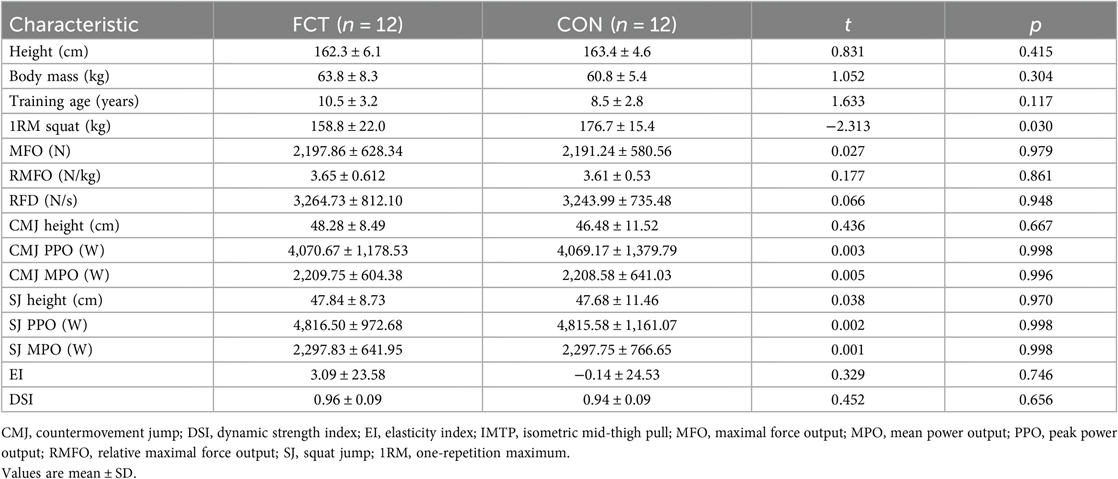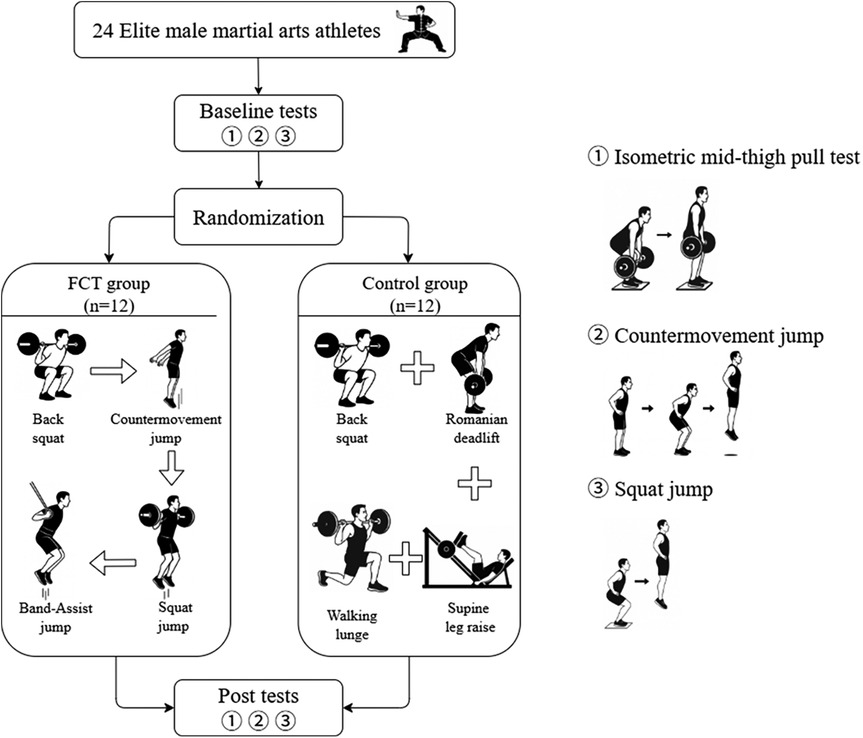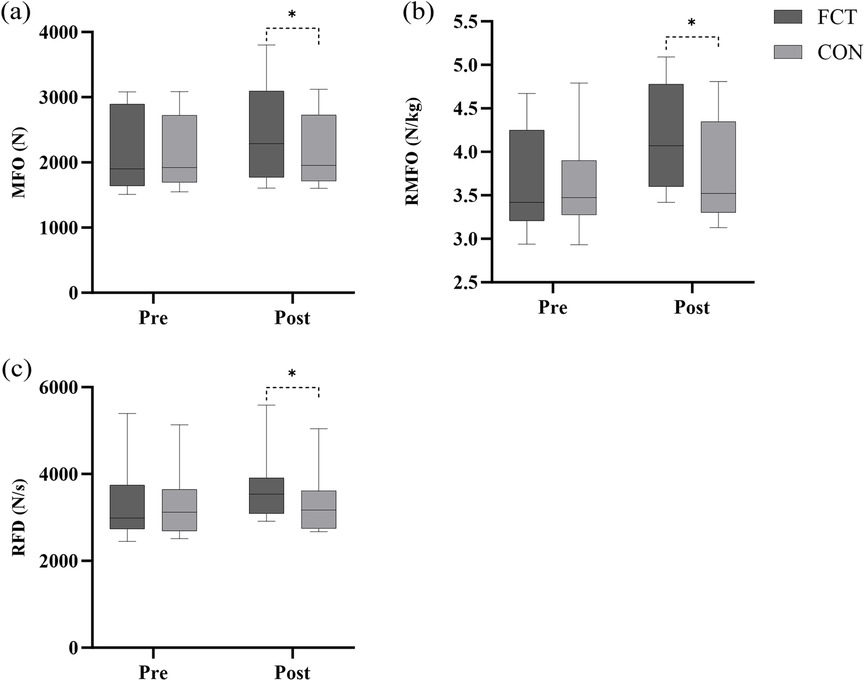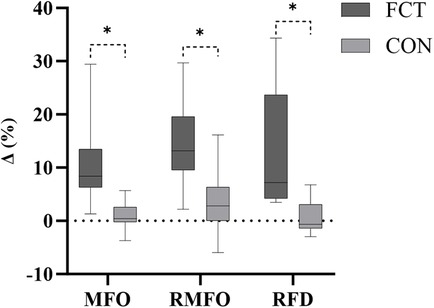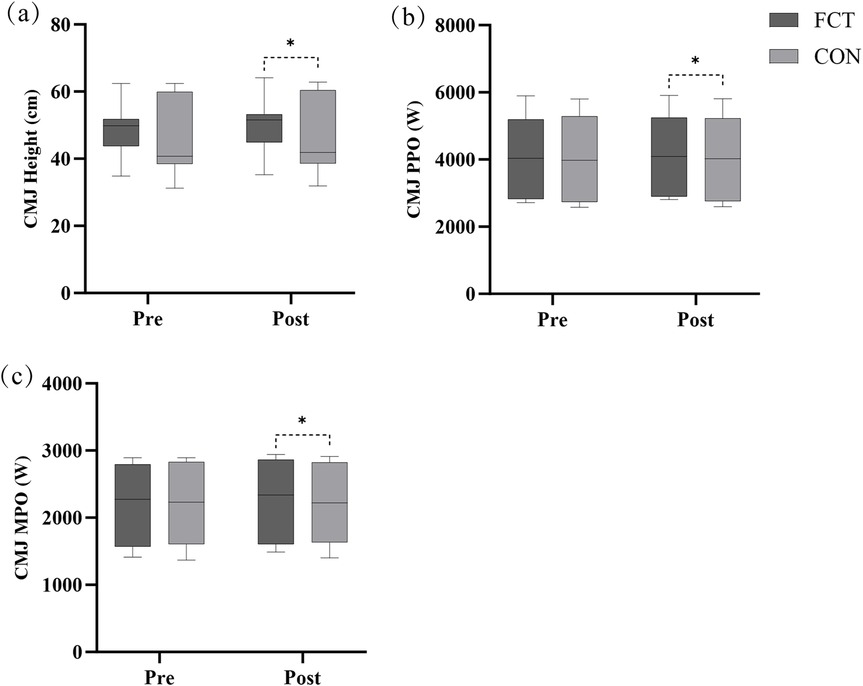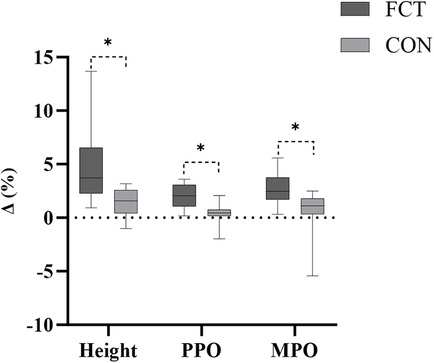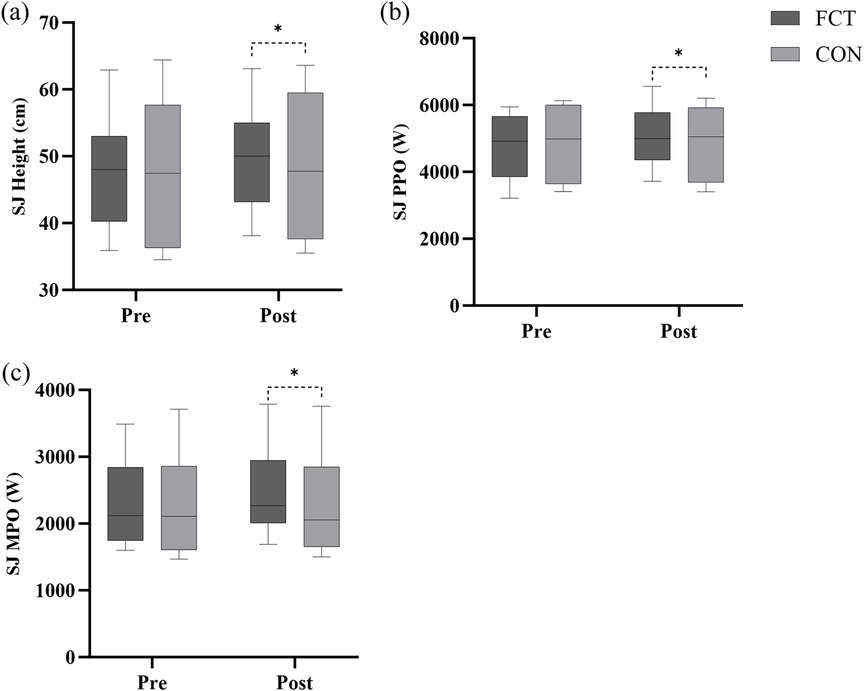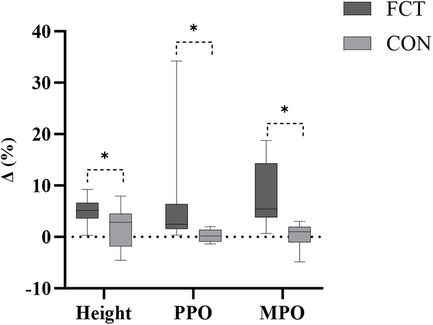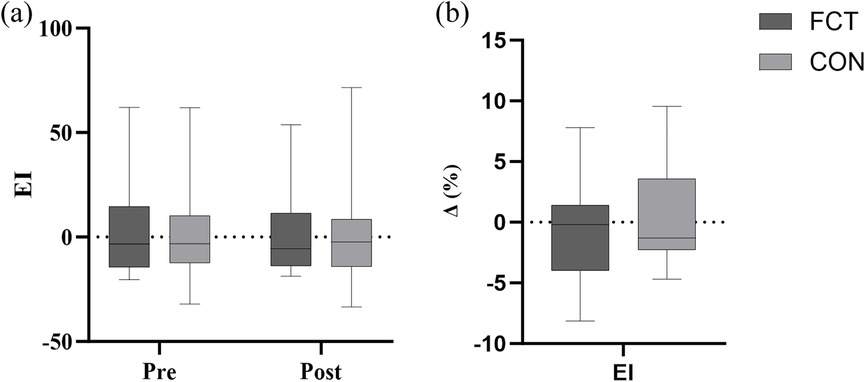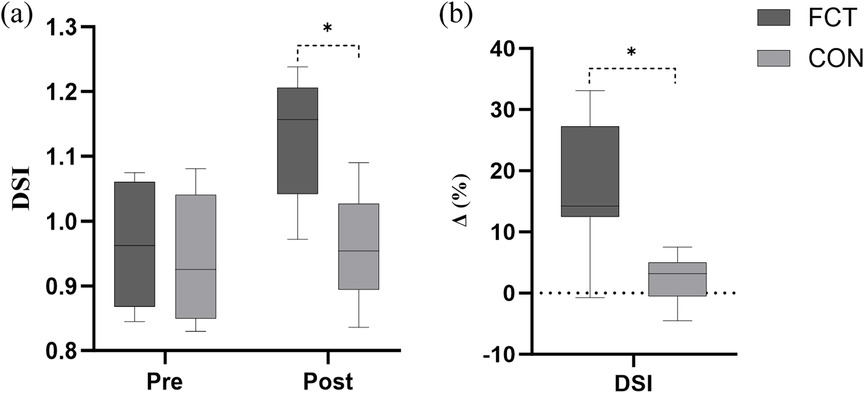- 1Department of Sports Health and Rehabilitation, Tianjin Vocational College of Sports, Tianjin, China
- 2College of Physical Education and Health Science, Chongqing Normal University, Chongqing, China
- 3Department of Sports Health and Rehabilitation, Tianjin University of Sport, Tianjin, China
- 4College of Sports and Health, Chengdu University of Traditional Chinese Medicine, Chengdu, Sichuan, China
- 5Tianjin Institute of Sports Science, Tianjin Sports Comprehensive Guarantee Center, Tianjin, China
Background: Lower limb strength and power are critical for martial arts athletes to perform complex movements such as aerial outward swings. French Contrast Training (FCT), which integrates heavy compound exercises, plyometrics, and assisted plyometric movements into a single session, has been proposed to elicit superior neuromuscular adaptations. However, the effectiveness of FCT in elite martial arts athletes remains unclear.
Objective: This study aimed to investigate the effects of an 8-week FCT program on lower limb strength and power in elite martial arts athletes.
Methods: In total, 24 elite male martial arts athletes were randomly assigned to the FCT group (n = 12) or the control group (n = 12). Both groups completed an 8-week (twice a week) training program. The FCT protocol included the following four sequential exercises per session: 85% one-repetition maximum (1RM) back squats, countermovement jumps (CMJs), 30% 1RM squat jumps (SJs), and band-assisted jumps. The control group performed traditional resistance training for the same muscle groups. The pre- and post-intervention assessments included isometric mid-thigh pulls [IMTPs; maximal force output (MFO), relative MFO, and rate of force development (RFD)], CMJs, SJs with jump height, peak power output (PPO), and mean power output (MPO), elasticity index (EI), and dynamic strength index (DSI). All the data were analyzed using the linear mixed model. Effect sizes were calculated using Cohen's d. Statistical significance was set at p < 0.05.
Results: The FCT group showed significantly greater improvements than the control group in IMTP (MFO: p < 0.001, d = 1.66; relative MFO: p = 0.001, d = 1.51; RFD: p = 0.001, d = 1.52), CMJ (jump height: p = 0.011, d = 1.14; PPO: p < 0.001, d = 1.61; MPO: p = 0.013, d = 1.11), SJ (jump height: p = 0.019, d = 1.03; PPO: p = 0.043, d = 0.88; MPO: p < 0.001, d = 1.63), EI (p = 0.521, d = −0.27), and DSI (p < 0.001, d = 2.07). No adverse events were reported.
Conclusions: This study provides preliminary evidence that French Contrast Training effectively enhances lower body strength and power in elite martial arts athletes.
1 Introduction
Lower limb strength and power are critical for martial arts athletes to succeed in complex movements (e.g., aerial outward swing) (1). Lower limb strength and power govern movement amplitude, execution speed, and postural control (2). Specifically, maximal strength provides take-off impulse, whereas rapid force development and eccentric braking reduce ground contact time, enable rapid acceleration, and stabilize landings in acrobatic skills (3–7). Consequently, lower limb strength and power underpin technical elements such as the aerial outward swing and align with competition criteria. Traditional training methods (e.g., resistance training and ballistic training) are integral to martial arts athletes' training programs, which elicit morphological and functional muscular adaptations and positively influence strength and jumping performance (8). Khazaei et al. reported that 8 weeks of traditional resistance training significantly improved the maximal strength, vertical jump, and sprint speed of elite taekwondo athletes (9). Lecce et al. separately reported that 4 weeks of resistance training and ballistic training (maximal intent) significantly improved elite athletes' propulsive power and propulsive velocity at the maximal and mean levels, rate of force development (RFD), and impulse (10, 11). However, resistance training predominantly targets the high-force, low-velocity region of the force–velocity curve (F–V curve). It provides limited stimulus to the high-velocity region, which constitutes a methodological limitation for developing rapid production and stretch-shortening cycle (SSC) efficiency (12). French Contrast Training (FCT) has garnered considerable attention for its potential to enhance maximal strength and power by strategically combining high-load, low-to moderate-load, and plyometric exercises in a single session, thereby stimulating adaptations across the full F–V curve (13–18). For example, a 6-week FCT program for professional soccer players has been shown to effectively improve their vertical jump, 30 m sprint, and dynamic balance compared to routine tactical drills (15). Similarly, Elbadry et al. demonstrated that an 8-week FCT program significantly enhanced the countermovement jump (CMJ), medicine ball throw, and triple jump performance of female college athletes. In addition, Rebelo et al. reported marked improvements in maximal strength, reactive strength index, and CMJ in recreational young athletes following FCT (19). These findings support the efficacy of FCT as an advanced training strategy for enhancing lower limb power among various athletic populations compared to routine training. However, the effects of FCT on athletes' power in comparison to traditional resistance training remain unclear.
FCT integrates the following four exercise phases into a single session: (1) a heavy compound exercise [e.g., 80%–90% one-repetition maximum (1RM) back squat], (2) a plyometric exercise (e.g., vertical jump), (3) a light-to-moderate load exercise (e.g., ∼30% 1RM barbell weighted jumps), and (4) an assisted plyometric exercise (e.g., band-assisted jump) (20, 21). This structured protocol systematically stimulates adaptations across the F–V curve to optimize neuromuscular function (22, 23). In addition, based on post-activation performance enhancement (PAPE) principles, this method integrates contrasting loads and movement velocities to stimulate the central nervous system and optimize force output (24). While FCT has demonstrated promising results in various athletic populations, limited research exists in martial arts athletes, whose performance relies heavily on lower limb strength and power for kicks, takedowns, and rapid directional changes.
This study aims to address this gap by evaluating the effects of an 8-week FCT protocol on lower limb strength and power in martial arts athletes. To evaluate these effects, we assessed force output, RFD, vertical jump height, vertical jump power output, elasticity index (EI), and dynamic strength index (DSI), thereby providing empirical evidence for FCT as a targeted conditioning strategy in martial arts. We hypothesized that FCT would elicit significantly greater improvements in maximal force output (MFO), relative MFO, RFD, jump height, peak power output (PPO), mean power output (MPO), EI, and DSI.
2 Materials and methods
2.1 Participants
Based on pre-experimental data (mean effect size for CMJ and squat jump (SJ) height: Cohen's d = 0.442; correlation coefficient r = 0.984), we calculated, using G*Power software (ANOVA analysis, f = 0.41, α = 0.05, power = 0.95, correlation coefficient r = 0.85) (Supplementary Table S1), that this study required 10 participants. In total, 24 elite martial arts athletes participated in this study. The participants were randomly assigned to either the FCT group (n = 12) or the control (CON) group (n = 12) (Table 1). All the participants were healthy, non-smokers, and not taking any medications or supplements. The eligibility criteria were as follows: male athletes who had competed in the quarterfinals of the National Junior Competition or achieved a top-three ranking in individual events or a top-two ranking in team events at the provincial level or higher. The study was approved by the ethics committee of Tianjin University of Sport (TJUS 2025-039), and all the procedures were conducted according to the Declaration of Helsinki. Before participating, all the athletes were fully informed of the potential benefits and risks of the study and provided written informed consent.
2.2 Study design
This study was an 8-week, single-blind (assessor-blind) randomized controlled trial (Figure 1). The participants were randomly assigned to either the FCT group or the control group using a computer-generated randomization sequence. Both groups completed their training protocols twice weekly, with at least 48 h of rest between sessions. The intervention was conducted during the preparatory phase of the competitive season. All the participants underwent a familiarization session before the intervention to learn the training procedures and testing protocols. Certified strength and conditioning coaches delivered standardized instruction to ensure consistent training implementation and evaluation. To control for potential circadian rhythm effects, all testing sessions were conducted at the same time of day for each participant. We used a digital thermohydrometer (SW-572, SNDWAY, China) to measure the environmental conditions, with an average temperature of 21.2 ± 0.3 °C and an average humidity of 29.0% ± 0.4%. The participants were instructed to refrain from strenuous physical activity for 48 h before each testing session and to avoid alcohol and caffeine intake within 24 h before testing.
2.2.1 Training protocol
The participants in the FCT group performed a structured four-phase training protocol, targeting distinct regions along the F–V curve. This protocol consisted of (1) a heavy compound exercise (85% 1RM back squat), (2) a plyometric exercise (CMJ with arm swing), (3) a light-to-moderate load exercise (30% 1RM SJ)], and (4) an assisted plyometric exercise (band-assisted jump). The participants in the control group engaged in traditional resistance training matched to the FCT protocol for total training duration and targeted muscle groups, including (1) 85% 1RM back squats, (2) 85% 1RM Romanian deadlifts, (3) 85% 1RM supine leg raises, and (4) 30% 1RM walking lunges. Both groups completed four sets of six to eight repetitions per exercise, with 3–4 min of rest between sets. All the participants began each training session with a standardized 10-min warm-up (Supplementary Table S2) and finished with a 5-min cooldown (Figure 2). Training loads were calculated from baseline 1RM values and were not adjusted during the 8-week intervention. Apart from the intervention, all the participants completed sport-specific technical training, with equivalent content and duration.
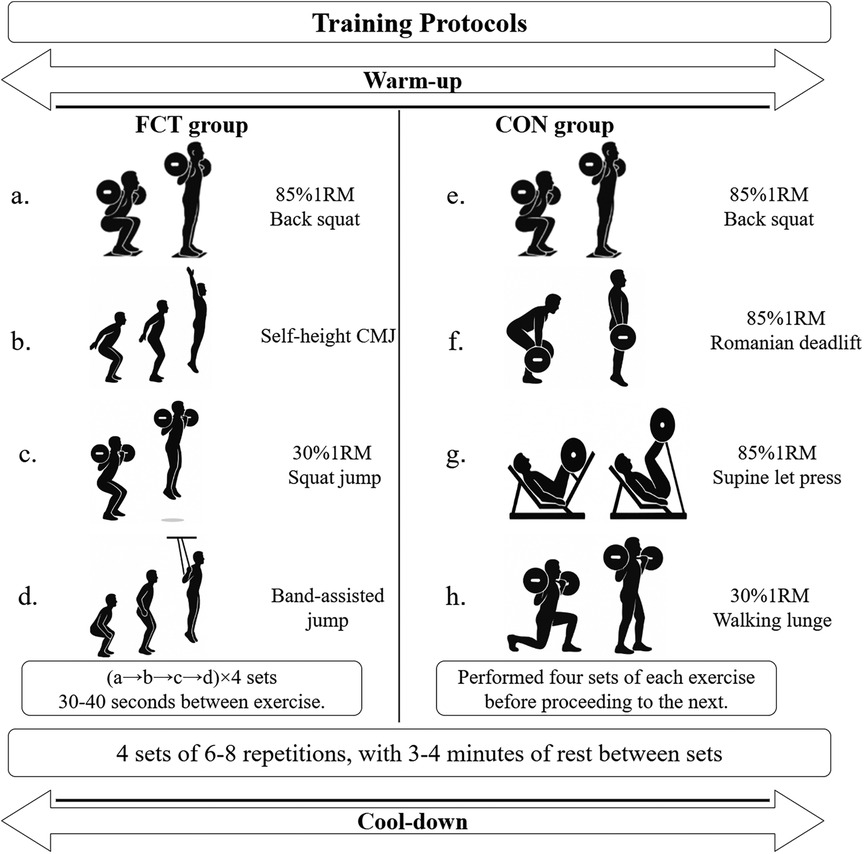
Figure 2. Schematic of the experimental protocol. (a, b, c, d) FCT training protocols; (e, f, g, h) CON training protocols.
Adherence was defined as sessions attended divided by sessions planned, multiplied by 100%, at both the participant and group levels.
2.2.2 Outcomes measurement
2.2.2.1 Isometric mid-thigh pull test
We utilized the isometric mid-thigh pull test (IMTP) to measure the force output and RFD of the participants. The IMTP test procedure (25) was as follows: (1) the assessor instructed the participants to stand on a force plate (Kistler Group, ≥1,000 Hz, Switzerland) with their feet shoulder-width apart and to fix the bar at mid-thigh height to imitate the second pull position of a high clean exercise; (2) the knee and hip angles of the participants were standardized at approximately 130° and 145° and verified using a handheld goniometer; and (3) the assessor instructed the participants to gradually build tension and then pull maximally “as fast and hard as possible” for 3–5 s while keeping their body rigid and maintaining complete foot contact. Verbal encouragement was provided throughout the test to ensure maximal effort. Each participant performed three maximal attempts with a 2-min rest between trials. The best results for MFO (N), relative MFO (N/kg), and peak RFD (N/s) were recorded for the analysis.
2.2.2.2 Countermovement jump test
We utilized the CMJ to evaluate the participants' lower limb power under dynamic conditions. The CMJ test procedure (26) was as follows: (1) the participants stood upright on a force platform (Kistler Group, ≥1,000 Hz, Switzerland) with their hands placed firmly on their iliac crests to minimize arm swing; and (2) upon receiving an auditory signal, the participants rapidly descended into a squat position and immediately performed a vertical jump. Each participant performed three maximal attempts with a 1-min rest between trials. Jump height was derived using the impulse–momentum method; the center-of-mass velocity was obtained by integrating the net vertical force (Fz − BW)/m [initial condition v (0) = 0], and height was computed from take-off velocity using the following equation: h = v2TO/(2 g) (5). The best results for jump height (cm), PPO (W), and MPO (W) were recorded for the analysis.
2.2.2.3 Squat jump test
We utilized the SJ test to evaluate participants' lower limb concentric power without the influence of the stretch-shortening cycle. The SJ test procedure (26) was as follows: (1) the participants started from a static squat position on a force platform (Kistler Group, ≥1,000 Hz, Switzerland) with their knees flexed at 90°, which was verified using a handheld goniometer; and (2) the participants executed a maximal vertical jump while keeping their hands placed on their iliac crests to minimize arm swing. Each participant performed three maximal attempts with a 1-min rest between trials. Jump height was calculated using the impulse–momentum method with the same integration procedure as CMJ. The best results for jump height (cm), PPO (W), and MPO (W) were recorded for the analysis.
2.2.2.4 EI
We calculated the EI to assess participants' ability to utilize the SSC during jumping. EI was determined using the following formula: (CMJ − SJ)/SJ × 100% (27). A higher EI signifies greater efficiency in SSC utilization.
2.2.2.5 DSI
We calculated the DSI to assess the balance between the participants’ maximal isometric force capacity and ballistic force expression. The DSI was determined using the following formula: CMJ peak force/IMTP MFO (28). A higher DSI reflects a greater translation of maximal isometric strength into dynamic explosive performance.
2.3 Statistical analysis
We present all the data as mean ± standard deviation (SD) and checked for normality using the Shapiro–Wilk test. We used the independent t-test to compare baseline variables between the FCT and CON groups (Table 1). We applied the linear mixed model (LMM) with fixed effects for group, time, and their interaction (group × time), and a random intercept for participants (REML, Satterthwaite, UK). We focused on the group × time interaction and reported the difference in change (ΔFCT − ΔCON) with 95% confidence intervals (CIs). When relevant, we examined simple effects with Sidak adjustment. We used the independent t-test to compare the percentage change (Δ%) between the groups and reported the results with 95% CIs. We calculated Cohen's d to ascertain the effect size, which was categorized as trivial (<0.20), small (0.20–0.49), moderate (0.50–0.79), or large (≥0.80). A p-value < 0.05 was considered statistically significant. All the analyses were performed using SPSS (version 27.0, IBM Statistics, Chicago, IL, USA).
3 Results
All the participants completed the 8-week training as prescribed in both groups, resulting in 100% session completion.
3.1 IMTP
3.1.1 MFO
A significant interaction effect between time and group was observed (F = 12.63, p = 0.002). The adjusted difference in change was 237.63 (p = 0.002, 95% CI: 98.97–376.29). The main effect of time showed a significant difference (F = 16.37, p < 0.001). The main effect of the group showed a significant difference (F = 13.00, p = 0.002) (Figure 3a; Table 2).
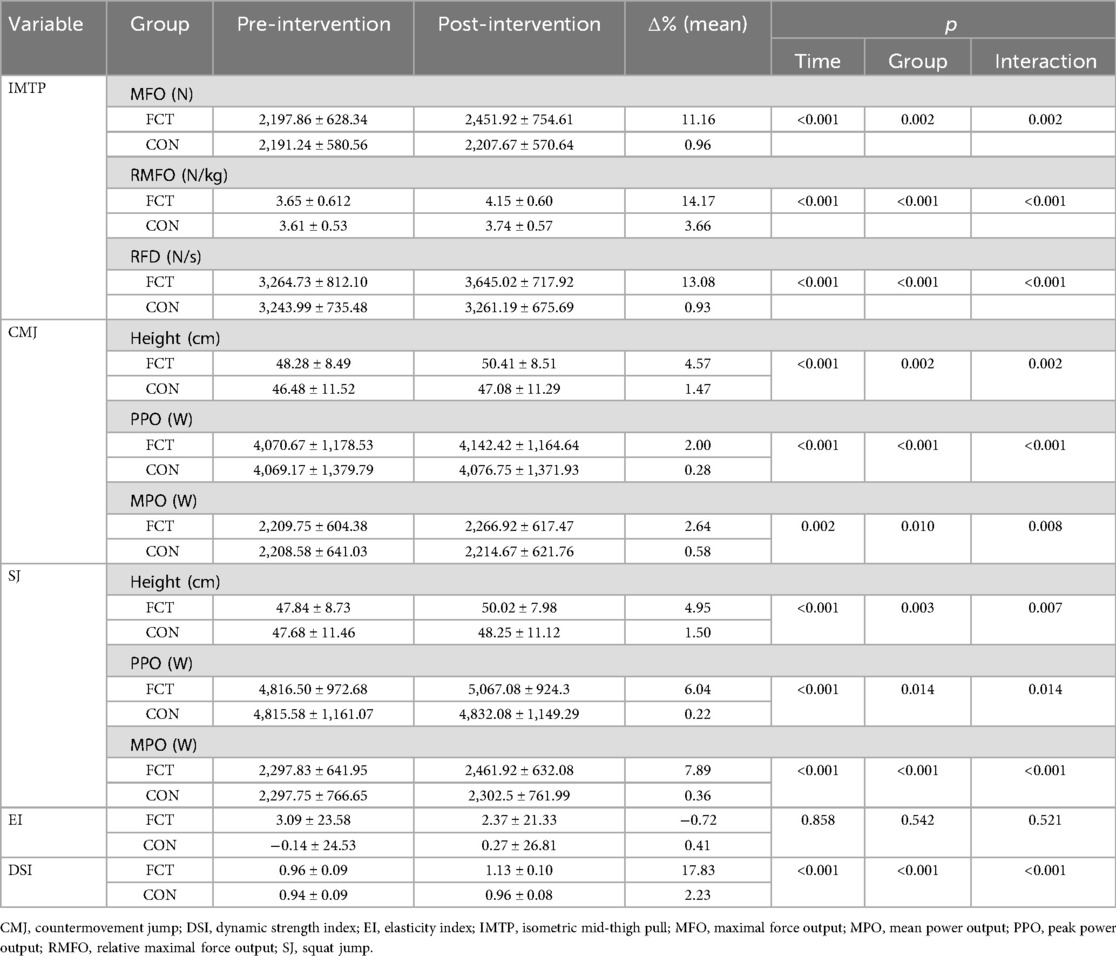
Table 2. The effects of the FCT and CON interventions on the athletic performance of the participants.
An independent t-test comparing the Δ% in MFO revealed a significant difference between the groups (t = 4.07, p < 0.001, 95% CI: 5.01–15.40, d = 1.66, large effect) (Figure 4).
3.1.2 Relative MFO
A significant interaction effect between time and group was observed (F = 15.38, p < 0.001). The adjusted difference in change was 0.369 (p < 0.001, 95% CI: 0.174–0.564). The main effect of time showed a significant difference (F = 44.19, p < 0.001). The main effect of the group showed a significant difference (F = 15.14, p < 0.001) (Figure 3b; Table 2).
An independent t-test comparing the Δ% in relative MFO revealed a significant difference between the groups (t = 3.70, p = 0.001, 95% CI: 4.61–16.40, d = 1.51, large effect) (Figure 4).
3.1.3 RFD
A significant interaction effect between time and group was observed (F = 18.90, p < 0.001). The adjusted difference in change was 363.10 (p < 0.001, 95% CI: 189.88–536.32). The main effect of time showed a significant difference (F = 22.65, p < 0.001). The main effect of the group showed a significant difference (F = 24.16, p < 0.001) (Figure 3c; Table 2).
An independent t-test comparing the Δ% in RFD revealed a significant difference between the groups (t = 3.72, p = 0.001, 95% CI: 5.39–18.92, d = 1.52, large effect) (Figure 4).
3.2 CMJ
3.2.1 Height
A significant interaction effect between time and group was observed (F = 11.07, p = 0.002). The adjusted difference in change was 1.53 (p = 0.002, 95% CI: 0.604–2.463). The main effect of time showed a significant difference (F = 35.19, p < 0.001). The main effect of the group showed a significant difference (F = 11.22, p = 0.002) (Figure 5a; Table 2).
An independent t-test comparing the Δ% in CMJ height revealed a significant difference between the groups (t = 2.80, p = 0.011, 95% CI: 0.80–5.40, d = 1.14, large effect) (Figure 6).
3.2.2 PPO
A significant interaction effect between time and group was observed (F = 17.55, p < 0.001). The adjusted difference in change was 64.17 (p < 0.001, 95% CI: 32.40–95.94). The main effect of time showed a significant difference (F = 26.82, p < 0.001). The main effect of the group showed a significant difference (F = 13.87, p < 0.001) (Figure 5b; Table 2).
An independent t-test comparing the Δ% in CMJ PPO revealed a significant difference between the groups (t = 3.94, p < 0.001, 95% CI: 0.82–2.62, d = 1.61, large effect) (Figure 6).
3.2.3 MPO
A significant interaction effect between time and group was observed (F = 8.39, p = 0.008). The adjusted difference in change was 51.08 (p = 0.008, 95% CI: 14.50–87.66). The main effect of time showed a significant difference (F = 12.86, p = 0.002). The main effect of the group showed a significant difference (F = 8.11, p = 0.010) (Figure 5c; Table 2).
An independent t-test comparing the Δ% in CMJ MPO revealed a significant difference between the groups (t = 2.71, p = 0.013, 95% CI: 0.48–3.63, d = 1.11, large effect) (Figure 6).
3.3 SJ
3.3.1 Height
A significant interaction effect between time and group was observed (F = 8.14, p = 0.007). The adjusted difference in change was 1.61 (p = 0.007, 95% CI: 0.47–2.75). The main effect of time showed a significant difference (F = 23.95, p < 0.001). The main effect of the group showed a significant difference (F = 9.62, p = 0.003) (Figure 7a; Table 2).
An independent t-test comparing the Δ% in SJ height revealed a significant difference between the groups (t = 2.52, p = 0.019, 95% CI: 0.61–6.29, d = 1.03, large effect) (Figure 8).
3.3.2 PPO
A significant interaction effect between time and group was observed (F = 7.02, p = 0.014). The adjusted difference in change was 243.08 (p = 0.014, 95% CI: 53.36–432.81). The main effect of time showed a significant difference (F = 7.96, p < 0.010). The main effect of the group showed a significant difference (F = 7.11, p = 0.014) (Figure 7b; Table 2).
An independent t-test comparing the Δ% in SJ PPO revealed a significant difference between the groups (t = 2.15, p = 0.043, 95% CI: 0.20–11.44, d = 0.88, large effect) (Figure 8).
3.3.3 MPO
A significant interaction effect between time and group was observed (F = 21.95, p < 0.001). The adjusted difference in change was 159.33 (p < 0.001, 95% CI: 88.80–229.87). The main effect of time showed a significant difference (F = 24.64, p < 0.001). The main effect of the group showed a significant difference (F = 21.38, p < 0.001) (Figure 7c; Table 2).
An independent t-test comparing the Δ% in SJ MPO revealed a significant difference between the groups (t = 3.98, p < 0.001, 95% CI: 3.61–11.45, d = 1.63, large effect) (Figure 8).
3.4 EI
A non-significant interaction effect between time and group was observed (F = 0.42, p = 0.521). The adjusted difference in change was 1.12 (p = 0.521, 95% CI: −2.45–4.70). The main effect of time showed a non-significant difference (F = 0.03, p = 0.858). The main effect of the group showed a non-significant difference (F = 0.39, p = 0.542) (Figure 9a). Due to normality violations, a Mann–Whitney U test was used to validate these findings (U = 72.00, p = 0.99) (Table 2).
An independent t-test comparing the Δ% in EI revealed a non-significant difference between the groups (t = −0.65, p = 0.521, 95% CI: −4.70–2.45, d = −0.27, small effect) (Figure 9b).
3.5 DSI
A significant interaction effect between time and group was observed (F = 29.47, p < 0.001). The adjusted difference in change was 0.147 (p < 0.001, 95% CI: 0.092–0.215). The main effect of time showed a significant difference (F = 46.92, p < 0.001). The main effect of the group showed a significant difference (F = 36.77, p < 0.001) (Figure 10a; Table 2).
An independent t-test comparing the Δ% in DSI revealed a significant difference between the groups (t = 5.06, p < 0.001, 95% CI: 9.21–21.98, d = 2.07, large effect) (Figure 10b).
4 Discussion
This study presents the first evidence that FCT enhances lower limb strength and power in elite martial arts athletes. These findings showed that, compared to traditional resistance training, FCT significantly improved MFO, relative MFO, and RFD during IMTP and improved CMJ and SJ height, PPO, MPO, and DSI, suggesting that FCT could be an effective training strategy for elite martial arts athletes.
The improvements in IMTP performance could be attributed to enhanced neural drive and motor unit recruitment (29). By combining heavy compound exercise with plyometric and ballistic exercises within a single session, FCT stimulates adaptations across the full of the F–V curve and elicits PAPE (30), transient potentiation of force output mediated by increased α-motoneuron excitability, heightened cortical activity, and phosphorylation of myosin regulatory light chains (31). Repeated exposure to this neural priming stimulus can lead to chronic adaptations, manifesting as increased maximal isometric strength and RFD (32). Cormier et al. demonstrated in their meta-analysis that the acute enhancement induced by PAPE can lead to significant chronic improvements in maximal strength and RFD (33). Previous studies primarily focused on how FCT improves the peripheral mechanism (13–17, 19, 21, 24, 34, 35); future studies should employ surface electromyography or transcranial magnetic stimulation to quantify changes in neural drive following FCT interventions.
The improvements in CMJ and SJ performance are consistent with previous studies. For instance, Rebelo et al. demonstrated that a 6-week FCT intervention can enhance the reactive strength index and CMJ performance in young athletes (19). Hernández-Preciado et al. found acute vertical jump potentiation after a single FCT session in recreational populations (34). The improvements in CMJ and SJ performance are likely due to the FCT protocol, which provides comprehensive neuromuscular stimulation across the full spectrum of the F–V curve (36). Specifically, heavy compound exercises increase maximal force output by enhancing neural drive and recruiting high-threshold motor units, thereby shifting the curve upward in the high-force, low-velocity domain (37). Plyometric and light-to-moderate load compound exercises target the moderate and high-velocity domains, facilitating improvements in RFD, motor unit firing rates, and muscle–tendon stiffness (38, 39). These combined effects likely result in enhanced excitation–contraction coupling, improved synchronization of agonist muscle activity, and more efficient utilization of both contractile and elastic elements during dynamic lower limb actions (40–43). Furthermore, repeated high-velocity exercises may induce morphological adaptations such as increased muscle fiber pennation angle (44), enhanced tendon compliance (45), and optimized muscle–tendon interaction, all of which are critical for power expression during explosive tasks (40).
Interestingly, although both CMJ and SJ performance improved, the relative gains were more pronounced in the SJ (PPO Δ 6.04%, MPO Δ 7.89%) than in the CMJ (PPO Δ 2.00%, MPO Δ 2.64%). This divergence likely reflects the distinct biomechanical and neuromuscular demands of the two jump types (26). The SJ begins from a static position and isolates concentric muscle action, requiring high levels of force generation without any contribution from elastic recoil or stretch reflexes (46). Thus, its improvement is closely linked to enhancements in intrinsic muscle contractile properties, neural drive (47), and intramuscular coordination (48), which are powerfully elicited by the heavy and ballistic loading components of FCT (49). In contrast, the CMJ incorporates a rapid eccentric phase preceding the concentric action, engaging the SSC and relying more on tendon stiffness, muscle–tendon synergy, and spinal reflex excitability (50, 51). The assisted plyometric exercises in FCT may have enhanced SSC efficiency by improving storage recoil behavior and reflex potentiation (52). This may be due to a ceiling effect in these elite athletes who already have efficient SSC utilization. The ceiling effect, defined as the reduced potential for measurable improvements in athletes who already perform at or near their physiological and biomechanical limits, can significantly attenuate observable gains from additional training interventions (53). Alternatively, the short inter-exercise rest intervals in FCT (30–40 s) may have resulted in residual neuromuscular fatigue during the plyometric phases, slightly dampening the acute potentiation of SSC-related performance (54, 55). Furthermore, the neural control strategies differ between the SJ and the CMJ: the SJ requires precise motor unit recruitment and high discharge rates to initiate movement from a static state, whereas the CMJ involves complex coordination of braking and propulsive phases (26). The DSI result complements the larger improvements observed in the SJ than in the CMJ, supporting the interpretation that FCT primarily strengthened concentric, task-specific force production. These differences suggest that FCT-induced PAPE may preferentially benefit concentric performance, as reflected in the larger improvements in the SJ metrics. This is consistent with previous studies. For instance, Sun et al. reported that the SJ exhibited greater improvements than the CMJ under PAPE conditions (56). In summary, these findings suggest that FCT induces a more substantial training stimulus on concentric dominant actions. FCT is an effective method for converting maximal strength into dynamic jump performance. To further optimize SSC efficiency, training should focus on reactive plyometrics, rapid stretch loading, and eccentric control, thereby challenging the pre-stretch phases. This has important implications for sport-specific performance, particularly in martial arts, where athletes must execute forceful movements from static or transitional postures with minimal preparatory loading. Practically, coaches can use FCT to enhance lower limb strength and power, scheduling two weekly sessions with at least 48 h of recovery. Future studies should further dissect these mechanisms using time–force curve analysis, ultrasound-based muscle–tendon assessment, and reflex latency testing to clarify how different FCT components contribute to concentric vs. SSC-driven performance gains.
4.1 Limitations
This study has several limitations. It involved a small sample of elite male martial artists, limiting its generalizability and neglecting gender differences. The observed effects were often small, necessitating cautious interpretation. In addition, the absence of physiological and neuromuscular biomarkers constrained mechanistic understanding, and the lack of fatigue response data hindered a comprehensive view of training adaptations. Future research should include larger, more diverse samples, explore gender-specific responses, incorporate relevant biomarkers, and employ longitudinal designs to assess the effect of FCT on combat athletes.
5 Conclusion
This study provides preliminary evidence that FCT may have advantages over traditional resistance training in improving lower limb strength and power among elite martial arts athletes. These findings imply a possible role for FCT within periodized training programs. However, due to the small sample size, the exclusive focus on elite male athletes, and the limited magnitude of some effects, the results should be interpreted with caution. Future research should confirm these findings across different martial arts disciplines, genders, and training levels, and examine the long-term effects of FCT using biomechanical and physiological measures.
Data availability statement
The original contributions presented in the study are included in the article/Supplementary Material, further inquiries can be directed to the corresponding authors.
Ethics statement
This study involving humans was approved by the Ethics Committee of Tianjin University of Sport, Tianjin, China. This study was conducted in accordance with the local legislation and institutional requirements. The participants provided their written informed consent to participate in this study.
Author contributions
HC: Software, Project administration, Formal analysis, Methodology, Writing – review & editing, Supervision, Investigation, Writing – original draft, Resources, Data curation, Conceptualization, Validation. ZZ: Conceptualization, Methodology, Supervision, Investigation, Validation, Data curation, Software, Writing – review & editing, Resources, Writing – original draft, Project administration, Formal analysis. XZ: Writing – review & editing, Data curation, Supervision, Methodology. LC: Methodology, Data curation, Investigation, Writing – review & editing, Supervision. JD: Data curation, Writing – review & editing, Supervision, Methodology. ZY: Writing – review & editing, Supervision.
Funding
The author(s) declare that no financial support was received for the research and/or publication of this article.
Conflict of interest
The authors declare that the research was conducted in the absence of any commercial or financial relationships that could be construed as a potential conflict of interest.
Generative AI statement
The author(s) declare that Generative AI was used in the creation of this manuscript. The authors used ChatGPT-4o (OpenAI, 2024) for linguistic enhancement in the Introduction and Conclusion sections. This was done by rephrasing author-written sentences using the prompt: “Rewrite this sentence in an academic language: [SENTENCE]”. The AI-generated text was subsequently reviewed and edited by the authors. All scientific content, analysis, and interpretations were independently written by the authors without the involvement of AI.
Any alternative text (alt text) provided alongside figures in this article has been generated by Frontiers with the support of artificial intelligence and reasonable efforts have been made to ensure accuracy, including review by the authors wherever possible. If you identify any issues, please contact us.
Publisher's note
All claims expressed in this article are solely those of the authors and do not necessarily represent those of their affiliated organizations, or those of the publisher, the editors and the reviewers. Any product that may be evaluated in this article, or claim that may be made by its manufacturer, is not guaranteed or endorsed by the publisher.
Supplementary material
The Supplementary Material for this article can be found online at: https://www.frontiersin.org/articles/10.3389/fspor.2025.1686891/full#supplementary-material
References
1. Wang X, Soh KG, Deng N, Zhang D, Cao S, Samsudin S. Effects of functional training on muscle strength, jumping, and functional movement screen in wushu athletes: a systematic review. Heliyon. (2024) 10(2):e24087. doi: 10.1016/j.heliyon.2024.e24087
2. Suchomel TJ, Nimphius S, Stone MH. The importance of muscular strength in athletic performance. Sports Med. (2016) 46:1419–49. doi: 10.1007/s40279-016-0486-0
3. Barker LA, Harry JR, Mercer JA. Relationships between countermovement jump ground reaction forces and jump height, reactive strength index, and jump time. J Strength Cond Res. (2018) 32(1):248–54. doi: 10.1519/JSC.0000000000002160
4. Fleeton JRM, Sanders RH, Fornusek C. Impact of maximal strength training on countermovement jump phase characteristics in athletes with cerebral palsy. J Sports Sci. (2022) 40(19):2118–27. doi: 10.1080/02640414.2022.2137303
5. Linthorne NP. Analysis of standing vertical jumps using a force platform. Am J Phys. (2001) 69:1198–204. doi: 10.1119/1.1397460
6. Pavlasová K, Bizovská L, Gába A, Farana R, Janura M. Biomechanics of landing in gymnasts: a scoping review. Front Sports Act Living. (2025) 7:1602058. doi: 10.3389/fspor.2025.1602058
7. Thomas C, Jones PA, Rothwell J, Chiang CY, Comfort P. An investigation into the relationship between maximum isometric strength and vertical jump performance. J Strength Cond Res. (2015) 29(8):2176–85. doi: 10.1519/JSC.0000000000000866
8. Fei Z. Influences of strength training on performance in martial arts athletes. Rev Bras Med Esporte. (2023) 29:e2023_0064. doi: 10.1590/1517-8692202329012023_0064
9. Khazaei L, Parnow A, Amani-Shalamzari S. Comparing the effects of traditional resistance training and functional training on the bio-motor capacities of female elite taekwondo athletes. BMC Sports Sci Med Rehabil. (2023) 15(1):139. doi: 10.1186/s13102-023-00754-9
10. Lecce E, Romagnoli R, Frinolli G, Felici F, Piacentini MF, Bazzucchi I. Exerting force at the maximal speed drives the increase in power output in elite athletes after 4 weeks of resistance training. J Appl Physiol. (2025) 125(2):327–38. doi: 10.1007/s00421-024-05604-1
11. Lecce E, Romagnoli R, Maffiuletti NA, Frinolli G, Felici F, Piacentini MF, et al. In the reign of velocity: ballistic training enhances rapid force production in chronically strength-trained athletes. Int J Sports Physiol Perform. (2025) 1:1–12. doi: 10.1123/ijspp.2025-0115
12. Cormie P, McGuigan MR, Newton RU. Developing maximal neuromuscular power: part 2—training considerations for improving maximal power production. Sports Med. (2011) 41:125–46. doi: 10.2165/11538500-000000000-00000
13. Girginer FG, Soyugür B, Alemdaroğlu BU. Futbolcularda fransız kontrast yönteminin aktivasyon sonrası performans artışına etkisi: deneysel araştırma. Turk Klin J Sports Sci. (2024) 16(2):1–7. doi: 10.5336/sportsci.2023-101140
14. Noufal KVI, Vasanthi G, Elayaraja M, Murugesan R, Rajpoot YS, Govindasamy K, et al. Impact of French contrast training on field hockey player’s biomotor and physiological parameters: a pretest-posttest study. Retos-Nuevas Tendencias En Educacion Fisica Deporte Y Recreacion. (2024) 58:1097–105. doi: 10.47197/retos.v58.106974
15. Türkarslan B, Deliceoglu G. The effects of the French contrast method on soccer player’s jumping, sprinting and balance performance. J Musculoskelet Neuronal Interact. (2024) 24(2):209–15.
16. Valappil INK, Vasanthi G, Elayaraja M, Orhan BE, Astuti Y, Katanic B, et al. Impact of three weekly sessions of complex versus French contrast training on physical and physiological responses in field hockey players: a randomized control trial. Monten J Sports Sci Med. (2024) 21 (1):67–80. doi: 10.26773/mjssm.250308
17. Welch ML, Lopatofsky ET, Morris JR, Taber CB. Effects of the French contrast method on maximum strength and vertical jumping performance. Paper presented at the 14th Annual Coaching and Sport Science College. East Tennessee State University, Johnson City, TN (2019).
18. Zhao Z, Ma Z, Wu C, Zheng X, Liu T, Deng N, et al. The effects of French contrast training on lower limb athletic performance in healthy adults: a systematic review and meta-analysis. Front Physiol. (2025) 16:1672353. doi: 10.3389/fphys.2025.1672353
19. Rebelo A, Pereira JR, Martinho DV, Valente-Dos-Santos J. Effects of a velocity-based complex training program in young female artistic roller skating athletes. J Hum Kinet. (2023) 86:217–34. doi: 10.5114/jhk/159654
20. Long M, Fee C, Taber C. The French contrast method—theory and application. Natl Strength Cond Assoc. (2023) 9:40–7.
21. Elbadry N, Hamza A, Pietraszewski P, Alexe DI, Lupu G. Effect of the French contrast method on explosive strength and kinematic parameters of the triple jump among female college athletes. J Hum Kinet. (2019) 69:225–30. doi: 10.2478/hukin-2019-0047
22. Dietz C, Peterson BJ. Triphasic training: a systematic approach to elite speed and explosive strength performance. Bye Dietz Sports Enterprise (2012).
23. Kons RL, Orssatto LB, Ache-Dias J, De Pauw K, Meeusen R, Trajano GS, et al. Effects of plyometric training on physical performance: an umbrella review. Sports Med Open. (2023) 9(1):4. doi: 10.1186/s40798-022-00550-8
24. Cengizel ÇÖ, Şenel Ö. Acute effects of the French contrast method and post activation potentiation on 3× 3 basketball game demands and thermal asymmetry responses. Appl Sci. (2025) 15(2):678. doi: 10.3390/app15020678
25. Comfort P, Dos’ Santos T, Beckham GK, Stone MH, Guppy SN, Haff GG, et al. Standardization and methodological considerations for the isometric midthigh pull. Strength Cond J. (2019) 41(2):57–79. doi: 10.1519/SSC.0000000000000433
26. Van Hooren B, Zolotarjova J. The difference between countermovement and squat jump performances: a review of underlying mechanisms with practical applications. J Strength Cond Res. (2017) 31(7):2011–20. doi: 10.1519/JSC.0000000000001913
27. Pradas F, Rapún M, Martínez P, Castellar C, Bataller V, Carrasco L. An analysis of jumping force manifestation profile in table tennis. Int J Table Tennis Sci. (2012) 7:19–23.
28. Šmite Z, Paiķis A, Plakane L. Data visualization for dynamic strength index: a qualitative approach for enhanced interpretation and decision-making. In: Proceedings of the 12th International Conference on Sport Sciences Research and Technology Support (icSPORTS 2024); Portugal. Porto: SciTePress (2024). p. 271–6.
29. Lecce E, Amoruso P, Vecchio AD, Casolo A, Felici F, Farina D, et al. Neural determinants of the increase in muscle strength and force steadiness of the untrained limb following a 4 week unilateral training. J Physiol. (2025) 603(12):3605–30. doi: 10.1113/JP288954
30. Aytaç T, İşler AK. Beyond the warm-up: understanding the post-activation performance enhancement. Spor Hekimliği Dergisi. (2025) 60(3):114–21.
31. Tillin NA, Bishop D. Factors modulating post-activation potentiation and its effect on performance of subsequent explosive activities. Sports Med. (2009) 39(2):147–66. doi: 10.2165/00007256-200939020-00004
32. Contreras B. Post-activation potentiation: theory and application. Weblog: the Glute Guy. April 5, 2010.
33. Cormier P, Freitas TT, Rubio-Arias JÁ, Alcaraz PE. Complex and contrast training: does strength and power training sequence affect performance-based adaptations in team sports? A systematic review and meta-analysis. J Strength Cond Res. (2020) 34(5):1461–79. doi: 10.1519/JSC.0000000000003493
34. Hernández-Preciado JA, Baz E, Balsalobre-Fernández C, Marchante D, Santos-Concejero J. Potentiation effects of the French contrast method on vertical jumping ability. J Strength Cond Res. (2018) 32(7):1909–14. doi: 10.1519/JSC.0000000000002437
35. Salam MB, Sherif S. Effect of French contrast training on bone mineral density and complex skills performance for soccer players. Ovidius Univ Ann Ser Phys Educ Sport Sci Mov Health. (2020) 20(2):232–9.
36. Cormier P, Freitas TT, Loturco I, Turner A, Virgile A, Haff GG, et al. Within session exercise sequencing during programming for complex training: historical perspectives, terminology, and training considerations. Sports Med. (2022) 52(10):2371–89. doi: 10.1007/s40279-022-01715-x
37. Rong W, Geok SK, Samsudin S, Zhao Y, Ma H, Zhang X. Effects of strength training on neuromuscular adaptations in the development of maximal strength: a systematic review and meta-analysis. Sci Rep. (2025) 15(1):1–18. doi: 10.1038/s41598-025-03070-z
38. Maffiuletti NA, Aagaard P, Blazevich AJ, Folland J, Tillin N, Duchateau J. Rate of force development: physiological and methodological considerations. Eur J Appl Physiol. (2016) 116:1091–116. doi: 10.1007/s00421-016-3346-6
39. Ramírez-delaCruz M, Bravo-Sánchez A, Esteban-García P, Jiménez F, Abián-Vicén J. Effects of plyometric training on lower body muscle architecture, tendon structure, stiffness and physical performance: a systematic review and meta-analysis. Sports Med Open. (2022) 8(1):40. doi: 10.1186/s40798-022-00431-0
40. Hirayama K, Iwanuma S, Ikeda N, Yoshikawa A, Ema R, Kawakami Y. Plyometric training favors optimizing muscle–tendon behavior during depth jumping. Front Physiol. (2017) 8:16. doi: 10.3389/fphys.2017.00016
41. Wilson MT, Hunter AM, Fairweather M, Kerr S, Hamilton DL, Macgregor LJ. Enhanced skeletal muscle contractile function and corticospinal excitability precede strength and architectural adaptations during lower-limb resistance training. Eur J Appl Physiol. (2023) 123(9):1911–28. doi: 10.1007/s00421-023-05201-8
42. Chimera NJ, Swanik KA, Swanik CB, Straub SJ. Effects of plyometric training on muscle-activation strategies and performance in female athletes. J Athl Train. (2004) 39(1):24.15085208
43. Kubo K, Morimoto M, Komuro T, Yata H, Tsunoda N, Kanehisa H, et al. Effects of plyometric and weight training on muscle-tendon complex and jump performance. Med Sci Sports Exerc. (2007) 39(10):1801–10. doi: 10.1249/mss.0b013e31813e630a
44. Aslam S, Habyarimana JDD, Bin SY. Neuromuscular adaptations to resistance training in elite versus recreational athletes. Front Physiol. (2025) 16:1598149. doi: 10.3389/fphys.2025.1598149
45. Kubo K, Ishigaki T, Ikebukuro T. Effects of plyometric and isometric training on muscle and tendon stiffness in vivo. Physiol Rep. (2017) 5(15):e13374. doi: 10.14814/phy2.13374
46. Gillen ZM, Jahn LE, Shoemaker ME, McKay BD, Mendez AI, Bohannon NA, et al. Effects of eccentric preloading on concentric vertical jump performance in youth athletes. J Appl Biomech. (2019) 35(5):327–35. doi: 10.1123/jab.2018-0340
47. Marinšek M, Samardžija M. Association between muscles’ contractile properties and jumping performance in gymnasts. Sci Gymnast J. (2020) 12(1):75–86. doi: 10.52165/sgj.12.1.75-86
48. Giroux C, Guilhem G, Chollet D, Rabita G. Muscle coordination in loaded squat jump. Comput Methods Biomech Biomed Engin. (2014) 17(Suppl 1):158–9. doi: 10.1080/10255842.2014.931621
49. Folland JP, Williams AG. Morphological and neurological contributions to increased strength. Sports Med. (2007) 37(2):145–68. doi: 10.2165/00007256-200737020-00004
50. Jo I, Lee H-D. Joint coordination and muscle-tendon interaction differ depending on the level of jumping performance. J Sports Sci Med. (2023) 22(2):189. doi: 10.52082/jssm.2023.189
51. Seiberl W, Hahn D, Power GA, Fletcher JR, Siebert T. The stretch-shortening cycle of active muscle and muscle-tendon complex: what, why and how it increases muscle performance? Front Physiol. (2021) 12:693141. doi: 10.3389/fphys.2021.693141
52. Makaruk H, Starzak M, Suchecki B, Czaplicki M, Stojiljković N. The effects of assisted and resisted plyometric training programs on vertical jump performance in adults: a systematic review and meta-analysis. J Sports Sci Med. (2020) 19(2):347.32390728
53. Barbalho M, Coswig VS, Steele J, Fisher JP, Giessing J, Gentil P, et al. Evidence of a ceiling effect for training volume in muscle hypertrophy and strength in trained men—less is more? Int J Sports Physiol Perform. (2020) 15(2):268–77. doi: 10.1123/ijspp.2018-0914
54. Drinkwater EJ, Lane T, Cannon J. Effect of an acute bout of plyometric exercise on neuromuscular fatigue and recovery in recreational athletes. J Streng Cond Res. (2009) 23(4):1181–6. doi: 10.1519/JSC.0b013e31819b79aa
55. Staniszewski M, Tkaczyk J, Kęska A, Zybko P, Mróz A. Effect of rest duration between sets on fatigue and recovery after short intense plyometric exercise. Sci Rep. (2024) 14(1):15080. doi: 10.1038/s41598-024-66146-2
Keywords: French Contrast Training, elite martial arts athletes, isometric mid-thigh pull, countermovement jump, squat jump, elasticity index, dynamic strength index
Citation: Chen H, Zhao Z, Zheng X, Cao L, Du J and Yu Z (2025) The effects of an 8-week French Contrast Training program on lower limb strength and power in elite martial arts athletes. Front. Sports Act. Living 7:1686891. doi: 10.3389/fspor.2025.1686891
Received: 16 August 2025; Accepted: 30 September 2025;
Published: 24 October 2025.
Edited by:
Limingfei Zhou, Beijing Sport University, ChinaReviewed by:
Edoardo Lecce, Foro Italico University of Rome, ItalyAbhijith M., University of Calicut, India
Izham Cid-Calfucura, Universidad de Santiago de Chile (USACH), Chile
Maisarah Shari, Perpustakaan Universiti Teknologi MARA, Malaysia
Copyright: © 2025 Chen, Zhao, Zheng, Cao, Du and Yu. This is an open-access article distributed under the terms of the Creative Commons Attribution License (CC BY). The use, distribution or reproduction in other forums is permitted, provided the original author(s) and the copyright owner(s) are credited and that the original publication in this journal is cited, in accordance with accepted academic practice. No use, distribution or reproduction is permitted which does not comply with these terms.
*Correspondence: Zhongtao Yu, dGpnbXR6amNAMTYzLmNvbQ==; Jingtao Du, MTM4ODAyOTU3MjBAMTYzLmNvbQ==
†These authors have contributed equally to this work and share first authorship
 Hao Chen1,†
Hao Chen1,† Ziren Zhao
Ziren Zhao Xin Zheng
Xin Zheng